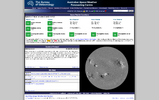SOLAR CYCLE 25 ACTIVITY REPORT JULY 27_2023
There are currently 11 sunspot regions on the solar disk: AR3376, AR3377, AR3378 AR3379, AR3380, AR3381, AR3382, AR3383, AR3384, and new regions AR3385, AR3386

AR3373 is gone
Total number of sunspots has decreased to 137 (48 of these are grouped into 11 active regions) NOAA forecasts for the next 24h: 99% chance for C flares, 35% chance for M flares and 5% chance for X flares. All regions have stable magnetic fields.
● Auroral Activity
The geomagnetic field has been at unsettled to minor storm levels for the past 24 hours. On July 26 Solar wind speed reached a peak of 587 km/s (Moderate speed) at 16:14 UTC. Total IMF reached 15 nT at 22:13 UTC
Aurora Oval Bz: 2.51 nT North

● Current Conditions at 03:55 UTC on July 27
▪︎ Geospace quiet (kp 2)
▪︎ Solar wind speed record: 494.4 km/sec (Elevated speed)
▪︎ density: 1.63 p/cm³ (low density)
▪︎ Interplanetary Magnetic Field (IMF)
Bt: 7.31 nT
▪︎ Neutron Counts today: -2.2 % (Below average)
▪︎ X-ray Solar Flare: C9 at 23:01 UTC
▪︎ Sunspot number: 137 (SN 141 July 26)
▪︎ Spotless Days 2023 total: 0 days (0%)
▪︎ There are no significant equatorial coronal holes on the Earthside of the sun.
...
SpaceWeatherlive.com
SpaceWeather.com
Solar activity has been at moderate levels. The largest solar event of the period was a M4.6 event observed at 10:37 UTC on July 26 from AR3376 (N23W82) it caused a Minor R1 radio blackout over Africa


Region 3376 has been the most active, earlier at 04:28:UTC produced a M1.2 and then, at 15:51 UTC a M2
Region 3376 has been the most active, earlier at 04:28:UTC produced a M1.2 and then, at 15:51 UTC a M2
There are currently 11 sunspot regions on the solar disk: AR3376, AR3377, AR3378 AR3379, AR3380, AR3381, AR3382, AR3383, AR3384, and new regions AR3385, AR3386
AR3373 is gone
Total number of sunspots has decreased to 137 (48 of these are grouped into 11 active regions) NOAA forecasts for the next 24h: 99% chance for C flares, 35% chance for M flares and 5% chance for X flares. All regions have stable magnetic fields.
● Auroral Activity
The geomagnetic field has been at unsettled to minor storm levels for the past 24 hours. On July 26 Solar wind speed reached a peak of 587 km/s (Moderate speed) at 16:14 UTC. Total IMF reached 15 nT at 22:13 UTC
Aurora Oval Bz: 2.51 nT North
● Current Conditions at 03:55 UTC on July 27
▪︎ Geospace quiet (kp 2)
▪︎ Solar wind speed record: 494.4 km/sec (Elevated speed)
▪︎ density: 1.63 p/cm³ (low density)
▪︎ Interplanetary Magnetic Field (IMF)
Bt: 7.31 nT
▪︎ Neutron Counts today: -2.2 % (Below average)
▪︎ X-ray Solar Flare: C9 at 23:01 UTC
▪︎ Sunspot number: 137 (SN 141 July 26)
▪︎ Spotless Days 2023 total: 0 days (0%)
▪︎ There are no significant equatorial coronal holes on the Earthside of the sun.
...
SpaceWeatherlive.com
SpaceWeather.com







